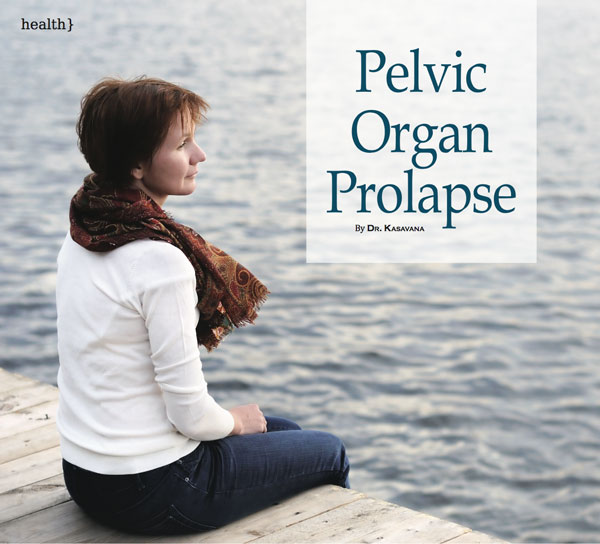Pelvic Organ Prolapse
By Dr. Kasavana

Pelvic organ prolapse, or POP, is a medical condition that many women don’t want to talk about, but can be very important for their quality of life. POP is when one or more of the pelvic organs drop from their normal position. It is caused by the relaxing of issue that provide normal support to the vagina. Approximately 10-percent of women will develop prolapse at some point in their life. This estimate is likely low as many women never seek medical attention because they do not realize there are treatments for POP related conditions.
There are different types of pelvic organ prolapse, and the term used to describe the site of prolapse helps describe the organ involved. Cystocele is the term for bulging of the top portion of the vaginal wall and is often associated with the descent of the bladder. Rectocele describes prolapse at the bottom of the vagina, often associated with rectal symptoms and problems with bowel movements. Apical prolapse is the term to describe descent of the inside of the vagina through the vaginal opening.
Patients with pelvic organ prolapse often have to modify or change their daily activities or avoid certain movements because of this problem. The risk of developing pelvic organ prolapse increases with the patient’s age and number of children, especially those delivered vaginally. Obesity or jobs that require strenuous physical activity such as lifting also increase a patient’s risk of POP. Pelvic organ prolapse is usually diagnosed with a pelvic examination in the office, but occasionally other tests such as an ultrasound, CT scan or MRI can help with the diagnosis.
Symptoms
The most common symptom of pelvic organ prolapse is a bulge or mass in the vagina or a sensation that something is falling out of the vagina. Patients often notice pressure or fullness in their lower belly that gets worse as the day progresses. Other symptoms include bladder problems like leaking urine when coughing, laughing or sneezing, or the sensation of having to urinate constantly. Patients may also have problems with bowel movements or issues with constipation. Some women, when going to the bathroom, need to press on the bulge before they can urinate or have a bowel movement.
Treatment
The good news is there is treatment for most women with pelvic organ prolapse! POP treatment depends on the severity of symptoms and identification of which pelvic organs have prolapsed.
Nonsurgical treatments include pelvic strengthening exercises and hormonal therapy. Pelvic exercises are aimed to strengthen the muscles that control urine ow and bowel movements. These are called “Kegel exercises,” and a doctor or nurse can instruct the patient how to perform the exercises. A more advanced treatment for mild prolapse involves a physical therapist prescribing an exercise routine aimed at strengthening the pelvic muscles. Occasionally topical estrogen cream may be prescribed to help strengthen the vaginal tissue in postmenopausal women.
Another nonsurgical treatment for POP is with a pessary. A pessary is a device that fits inside the vagina to help push the bulge back into place and hold it there. Pessaries come in different shapes and sizes and are individually fitted during an office visit. They are a viable option for patients who cannot tolerate or elect not to have surgery.
Surgical treatment for pelvic organ prolapse involves moving the prolapsed organ back to its proper anatomic location and strengthening the tissues that hold it in place. There are a variety of treatment options available. Traditionally surgeries were only done with large, open incisions, but modern surgical advances allow most patients to be treated with smaller incisions utilizing minimally invasive techniques. These treatments allow the patient less blood loss, less pain, and a quicker recovery time.
An additional procedure for pelvic prolapse is called a sacrocolpopexy. During this surgical procedure, a surgical mesh is used to return the a affected pelvic organs to their natural position. The mesh remains in place permanently and often resolves the patient’s symptoms. Sacrocolpopexy is often considered the best way to correct pelvic prolapse, resolve symptoms, and provide long-term support for the vagina.
Pelvic organ prolapse is a medical condition that can have a profound impact on a patient’s lifestyle and body image. The good news is most of these conditions can be treated, so contact your gynecologist today!
Dr. Kasavana is a daVinci trained minimally invasive gynecologic surgeon with a special interest in treating patients with pelvic organ prolapse including robotic sacrocolpopexy. He is currently seeing patients at Kalispell OB GYN and in Eureka at Eureka Health Prompt Care. Call to schedule an appointment at Kalispell OB GYN 406-752-5252.
